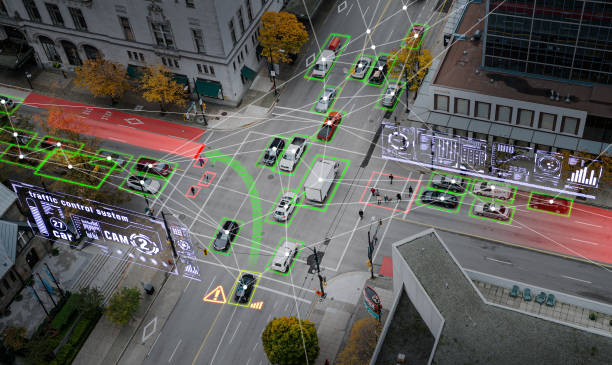



















Smart Mobility Systems are changing the way transport networks are managed and navigated by employing cutting-edge technology such as artificial intelligence (AI), data analytics, and networking. These systems go beyond traditional traffic management by incorporating real-time data, predictive analytics, and automated decision-making algorithms.
At inBlenda, we understand how intelligent traffic management solutions may help with the rising difficulties of urban traffic, population growth, and environmental deterioration. Our services go above and beyond by providing innovative solutions that improve sustainability, safety, reliability, and smooth traffic flows.
We aim to deliver seamless mobility experiences for individuals, businesses, and entire communities by using our expertise in intelligent traffic management and low-emission AI-driven shared and connected mobility. We can provide actionable insights that result in effective and efficient mobility solutions by utilising cutting-edge technology and real-time data.
This blog will cover a wide range of intelligent traffic management system topics, such as the most current technological advancements, the possibilities for smart mobility, and their potential consequences on our communities.
The primary focus of Mobility-as-a-Service (MaaS) is users. This new paradigm makes creating a passenger’s trip from point A to point B more seamless and integrated. No longer will passengers need to worry about purchasing separate tickets or paying for separate fees. MaaS offers users a single way to make reservations and pay for their different mobility needs by consolidating relevant services under one roof.
As a pioneer in smart mobility solutions, inBlenda is responsible for introducing state-of-the-art MaaS across Europe. MaaS is primarily concerned with improving the customer experience through the seamless integration of many modes of transport, ranging from shared mobility alternatives like carpooling, bike sharing and kick scooters to taxis, buses and trains. These systems enhance the entire journey experience by minimising waiting times, optimising transit options, and utilising artificial intelligence, connectivity, and data-driven insights.
By allowing communication between vehicles and infrastructure, smart mobility systems are transforming transport and paving the way for the development of connected and autonomous mobility. These cars can connect in real-time with traffic management systems and each other thanks to their sophisticated sensors and communication technology, which increase overall traffic efficiency and mitigate major impacts on road safety and the environment. Communication between a vehicle and any entity that might influence or be influenced by the vehicle is known as “vehicle-to-everything” (V2X) communication. This system of vehicular communication integrates many specialised forms of communication such as vehicle-to-infrastructure (V2I), vehicle-to-network (V2N), vehicle-to-vehicle (V2V), vehicle-to-pedestrian (V2P), and vehicle-to-device (V2D). The seamless integration of cooperative smart mobility systems with autonomous and networked vehicles ushers in a new era of intelligent mobility solutions, improving the efficiency of modern transport networks even further.
Advancements in vehicle connectivity and automation gave rise to Cooperative Intelligent Transport Systems (C-ITS), which play a critical role in revolutionising current transport systems and enabling the transition toward autonomous mobility. C-ITS are essential for enhancing traffic efficiency and road safety by facilitating the sharing of vital information about traffic conditions, accidents, and road dangers via real-time communication between vehicles, infrastructure, and traffic control systems. The extensive capability of conducting impact assessment and socio-economic analysis for C-ITS and autonomous driving by professionals like inBlenda helps create a safer and more effective smart mobility environment by improving situational awareness and facilitating proactive decision-making.
A key component of the idea of smart cities is smart mobility systems. The integration of diverse digital technologies, including big data analytics and the Internet of Things (IoT), within transport networks leads to enhanced public transit systems, more effective traffic management, and optimum routing. In the end, this improves sustainability, lessens its negative effects on the environment, and raises urban residents’ standard of living generally.
The reconfiguration of essential horizontal and vertical transport features at different railway stations and mobility hubs, such as gate line arrays, stairs, and lifts, is the emphasis of inBlenda’s expertise in smart Interchange Design. Additionally, through the utilisation of smart mobility systems and the integration of data-driven insights, inBlenda optimises passenger flow, decreases waiting times, and boosts overall efficiency in smart interchanges. As a consequence, travellers enjoy improved user experiences and increased convenience.
Through the promotion of shared and networked mobility solutions, inBlenda transforms the smart mobility industry. By combining sophisticated networking technologies, data-driven insights, and smart mobility systems, inBlenda facilitates the effective sharing of trips and vehicles, therefore lowering the number of private cars on the road. This strategy promotes eco-friendly and sustainable smart mobility solutions while addressing environmental issues and reducing traffic congestion.
Overall, smart mobility systems are influencing how mobility is designed in the future through a variety of means, including the creation of smart cities, connected and autonomous vehicles, cooperative communication systems, cross-border travel experiences, mobility transformation toward shared and less private vehicle use, and improved smart mobility interchange design. Being a market leader, inBlenda’s creative solutions push these applications of smart mobility systems forward, creating a more effective and sustainable mobility ecology.
By reducing traffic issues, smart mobility systems seek to maximise traffic efficiency. Users benefit from having access to historical traffic data, real-time running information about nearby conveniences, seat availability, and other information that shortens commutes and improves commuters’ safety and comfort.
AI-driven traffic management systems leverage real-time data from several sources, including GPS units, cameras, and sensors, to improve traffic flow predictions, lessen congestion, and shorten travel times. This results in lower emissions and increased fuel economy.
Globally, smart mobility systems have a bright future ahead of them thanks to developments in connectivity, data analytics, and automation technology that are fostering the creation of more sustainable and effective mobility networks. Smart mobility systems have an enormous potential to change the industry, from connected and driverless cars to smart city projects.
With the use of cutting-edge technologies like artificial intelligence, data analytics, and smart mobility systems, we provide unrivalled solutions to change how people travel. Our expertise in intelligent mobility management ensures efficient traffic flow, reduces traffic, and saves commuters valuable time.
But it goes beyond that. inBlenda does more than just streamline traffic patterns. Our data-driven insights provide useful information that enhances judgment and helps us create a seamless smart mobility management environment that is bright.
inBlenda is the partner you need, whether you’re a municipality, a Public Transport operator a mobility service provider aiming to improve urban mobility, a mobility corporation attempting to optimise operations or an individual searching for cost-effective and ecologically responsible solutions to go from point A to point B.





